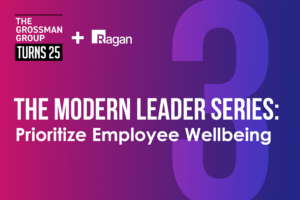Compassionate communication: How to talk about suicide at work
During National Suicide Prevention Month, Ragan’s Editor-in-Chief asks us to consider when our words and actions can become a matter of life and death.

When my boss didn’t show up to work one Monday in October 2019, her lack of notice was the first sign something was wrong. As our Content Director, she was also an expert communicator and project manager. As morning came and went, our team called around searching for answers.
We eventually learned that she died by suicide.
Were there signs at work that we could have picked up on? How could we be there for her family? What more was there to her legacy than the drive she brought and the deliverables she produced? Feeling rudderless, the content team worried about her young son who visited our office often. We learned he loved Pokémon during these visits, so we bought him Pokémon cards.
Piling into a minivan later that week to attend her funeral upstate, we spent several hours talking about the culture of business, the strains of being a middle manager always striving for more but feeling stuck, and the stress of being held accountable for the dropped balls other leaders who are not.
Becoming a middle manager myself brought a newfound empathy for all she went through, and I often wonder what fortifies me with the ability to navigate the stresses this work brings when others can’t.
Suicide rates in the US were on the decline from 2018-2020, according to the CDC, when they began to rise amid the pandemic. Over 49,000 people died by suicide in 2022, and the number climbed to a record high of 50,000 deaths in 2023. This is what the U.S. surgeon general meant when he called mental health “the defining health crisis of our time”.
When designer Kate Spade died by suicide in 2018, details about her note to her daughter and speculation about how she suffered silently gave way to many powerful personal essays about the impact of stigma around mental health conversations.
Understanding how comms can mitigate suicide contagion
The scope and scale of this discourse also introduced to many the concept of “suicide contagion”, which refers to the process whereby a suicide or suicidal act with a certain community can increase the likelihood that other vulnerable individuals within a social, geographical and psychological proximity are more at risk to take their own life.
This means that when someone dies by suicide in your organization or industry, the words you use to those in their orbit can sometimes be a matter of life or death.
“For someone already considering suicide, it’s possible to change their thoughts into action by exposing them to detailed suicide-related content, including graphic depictions or explanations of the death or revealing the method used,” wrote the National Alliance on Mental Illness. “Two days after the media irresponsibly reported on Kate Spade’s death by suicide, Anthony Bourdain used the same method to end his life.”
When tasked to craft communications about a death by suicide at your organization or in your community, follow the best practices of responsible suicide reporting:
- Rather than describing the method or location of the suicide, simply report the death as a suicide and keep all other information general.
- Rather than share the content of a suicide note, simply report that the note was found and exclude other details
- Rather than describe intimate details, keep personal information out of it.
- Rather than normalizing suicide as a common occurrence, point to coping skills, treatment and resources that are available in your Employee Assistance Plan (EAP) or other benefits.
- Rather than speculate or oversimplify motives, identify warning signs and risk factors that give context to the suicide.
- Rather than romanticizing or glamorizing the suicide, provide context or facts that don’t present it as a noble solution or heroic conclusion.
Canada’s Centre for Addiction and Mental Health compiled thorough language guidelines worth referencing to ensure you’re using the right words when communicating about suicide.
Ultimately, none of my speculation was helpful to destigmatizing my boss’ suicide or grounding it in practical terms. To the contrary, I now know that going down this train of discourse risks romanticizing suicide. I also know that it can amplify similar feelings in vulnerable, at-risk people within a community.
In an effort to avoid romanticization, I also wonder if some fellow leaders avoid discussing suicide altogether are unintentionally adding to its stigma and mystique.
There are still many leaders who aren’t comfortable talking about mental health. One tell here is when, rather than have a feelings-based conversation or ask a report what they need, a leader will couch all concerns squarely about the business. Defaulting this conversation to an HR lead only works if the HR lead has training that goes beyond regulatory and compliance. This is not often the case.
How managers can help
Of course, managers cannot be mistaken for therapists. Having boundaries means knowing when someone should be referred to professional help. But fortified with the right resources and guidance to facilitate conversations about mental health, they can help put someone on the right path.
During manager onboarding, this means training them to take protective measures during one-on-ones that acknowledge and show genuine concern for their report’s mental health. Those include.
- Assessing each report’s willingness and ability to talk about their mental health and emotions. It doesn’t mean pushing them to speak about it more than they are comfortable, simply giving them the space to know that it’s OK.
- Holistically discussing hobbies or interests outside work to build a holistic social report.
- Asking about their network of family or friends, while listening to learn if it supports them.
- Recommending professional support when a situation is outside the manager’s professional scope or advice. Communicating general knowledge about contacts for your EAP helps destigmatize outreach.
When these conversations advance to actual talk about suicide, managers must not be afraid to talk about it. Experts say that talking about suicide alone does not put the idea in someone’s mind, but only makes it less taboo.
Managers should understand that questions about mental health or suicide can be asked directly and sensitively at the same time.
“People will often initially hint at suicidal thoughts or use a metaphor (‘I just want to get out of everyone’s way’, or ‘I feel a burden to people’),” explains the Chartered Institute of Personnel and Development (CIPD).
As a general rule, the CIPD recommends asking simply and clearly something like, “Have you had thoughts about ending your life?” or “Do things get so bad for you that you think about suicide?”
“The actual words you use are less important than that they are clear and to the point. The fear of talking about suicide is always worse than actually talking about suicide.”
If a report opens up about these feelings, managers should follow up by asking if they have any plans or intentions to act on them and encourage them to contact their doctor as a first step.. Managers can also offer to contact a loved one on behalf of the report, asking for permission to hold onto the loved one’s contact information in moments of distress.
Remind managers to tell their reports that full confidentiality is not possible. If a report opens up to their manager about suicidal thoughts, the manager should be transparent about policy and explain that they may have to share information if they believe the report to be at risk. This means reporting back to HR or a senior manager as the case dictates.
While talking about suicide is never easy, empowering all people leaders across your organization to finding the right words and make time to communicate about difficult topics is part of the gig. Empowering all leaders to prioritize compassionate communication is one of the ways that our work helps change, and save, the lives of those around us.
If you or someone you know is experiencing a mental health, suicide or substance use crisis or emotional distress, reach out 24/7 to the 988 Suicide and Crisis Lifeline (formerly known as the National Suicide Prevention Lifeline) by dialing or texting 988 or using chat services at 988lifeline.org to connect to a trained crisis counselor. You can also get crisis text support via the Crisis Text Line by texting NAMI to 741741.







